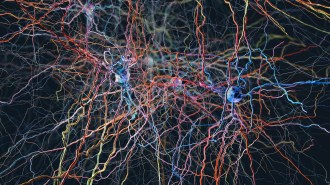Mining mouse movements to make more meds
A new screen for active drugs in mice can put drugs into classes. But can it find the drugs we’re looking for?
- More than 2 years ago
In pharmacology research, it seems like one test is never enough. If you want to test a new antidepressant, reviewers (and good logic) often demand that you use more than one test. A locomotor assay to see whether the new drug depresses or increases how much a mouse moves. A forced swim test or tail suspension test to see how it stacks up against other, known antidepressants. Does it increase swimming? Or climbing? Does it decrease immobility more or less than known antidepressants? You may want to use a chronic mild stress test, which exposes mice over a long period of time to things like mild cold, noise or light to induce stress. Does chronic exposure to your new antidepressant relieve the stress like other antidepressants do? What about responses to things like chronic bullying by other mice? Does it work then?
You don’t necessarily need to run all of these tests, but you usually do need to run more than one. After all, what if the drug decreases immobility in a forced swim test, like other antidepressants, but it also makes them race around the room … because it’s cocaine?
These are the kind of questions that pharmacologists end up asking. Often, to find new, potential antidepressants, for example, we end up matching them against other, known antidepressants in a series of these tests. If the drug performs well in all of them, doesn’t decrease locomotor activity but keeps the mice swimming and stops them from looking stressed after bullying, we might have something new.
But this is a lot of tests. A lot of tests, and a lot of time. Not to mention a lot of money. Many of these tests, like one for chronic mild stress, require days to weeks of dosing with the drug. Others require more than one test, meaning more than one batch of mice. And of course, if you end up with a drug that fails as an antidepressant, but looks like it might show something as a stimulant … well, that’s a whole new set of tests to do.
Wouldn’t it be nice if you could just run one test? One test that would give a profile so you knew the drug was this much stimulant, this must opiate, and that much antidepressant?
A group of researchers in Israel believe they have that test. And it’s very simple. One injection of drug, plunk the mouse into a large open field, and watch. Let the mouse go about its everyday business (or at least, as normal as its business can be in a blank open box). Watch for an hour, and use a series of data mining algorithms to pull out how similar the drug you are testing is to other, already classified drugs. Maybe it’s like an antidepressant, or an opiate. Maybe it’s in between.
To form the test, the authors tested a total of 41 drugs in six drug classes: the stimulants (cocaine, meth, etc.), the opiates (morphine, codeine, oxycontin), the psychomimetics (PCP, ketamine), alpha adrenergics (a type of stimulant that can also increase blood flow, like yohimbine), antidepressants (Prozac, Wellbutrin, Paxil), and the antipsychotics (like haloperidol and chlorpromazine). Each drug was tested across a range of doses, from low to high. For each one, they injected the dose into a C57 mouse, and let the mouse run in the open field for an hour while tracking its every move with analysis software.
Once they had all of the drugs, the scientists used pattern analysis to see what movement patterns were consistent across different types of drugs. For example, you would expect to see increased locomotor activity overall with stimulant like cocaine (aaaaand, whee!), but it turns out that they also decrease the amount of ground sniffing that an animal does. Opiates also decrease sniffing, but also decrease how much an animal accelerates, while psychostimulants don’t change acceleration. Antidepressants slow “progression towards the wall.”
They also got one behavior that they classified as a “universal drug detector,” or the sign that your mouse is on A drug, though which one might still be up for grabs. This is a measure of acceleration and deceleration. When a mouse starts moving, it STARTS, and when it stops, it doesn’t fool around. These sudden movements are part of what makes the little buggers so difficult to catch. But these sudden starts and stops are decreased by drugs. ALL drugs. Or at least, all the ones they tested. No matter what drug it was, sudden starts and stops were decreased, which the authors suggest makes the movements a useful detector of a mouse being “on” a drug, no matter what it is.
The authors came up with patterns that generalize across drug classes, and were able to pinpoint “test” drugs as being in particular classes (specifying buprenorphine as an opiate, for example) with fairly high specificity. The authors propose using the test as a screen for new psychiatric drugs to see how they profile against other drugs.
The drugs were only tested in one strain of laboratory mouse. These are some very detailed movements that probably differ between mouse strains. So if you’re not testing your drug in a C57 you might be SOL here. But once quantified for different strains, this could be a useful measure for categorizing drugs. The authors hope to be able to screen new drugs easily, classifying them into antidepressant, antipsychotic, etc., to help make drug discovering easier. The test makes it easy to classify drugs with other drugs that are similar.
But if we find new drugs that are similar to the previous drugs in this test, are they the drugs we are looking for?
This is where we run into some of the problems currently facing the development and understanding of psychiatric drugs. There are many drugs currently on the market for things like depression. Prozac, Wellbutrin, Celexa. I could go on. Most of the drugs act in a similar fashion, they increase levels of chemicals in the spaces between neurons, the synapse. The chemicals, neurotransmitters, are usually serotonin, dopamine, or norepinephrine, neurotransmitters that have been shown to have effects on mood. We can screen for them in the same tests, and they turn up positives in all of the behavioral tests for depression. They all have the same profile in this particular study. So they are all classified together.
But will new drugs, which may be more effective, always have the same behavioral effects in animals as the established drugs? After all, many scientists are looking to other systems FAR outside the realm of dopamine and serotonin when they are looking for antidepressants. These new drugs are very different. They may have similar behavioral effects in mice. Some of them do — ketamine, for example.
But … what if they don’t? What if, by using one test that throws drugs into a category based on a set of criteria, we are just going to end up picking the same old drugs, with the same old effectiveness? We may indeed find new drugs, but are they the drugs we are looking for?
After all, the antidepressants on the market now are good … but they aren’t that good. In fact, many patients do not respond to them at all. If we are going to find more effective drugs, we may need drugs that are NOTHING LIKE the current ones. Drugs that may end up having antidepressant effects in humans, but that don’t classify as antidepressants in this screen. They may, instead, come up positive on other antidepressant tests, ones that create behaviors in animals similar to depression in humans, like chronic mild stress or social defeat (mouse bullying).
This is why, when pharmacologists look for antidepressants, they already use more than one test. They use social defeat AND forced swim. Tail suspension AND chronic mild stress. When looking for a new drug, you want to see both how similar it is to other known drugs (say, by using the screen developed here), but also how effective it is on depressive-like behaviors, like those in chronic mild stress.
So while I think it’s a really nice, useful thing to have this test, to be able to do something relatively simple and not stressful, it’s also important to recognize that this screen can’t work alone. It might be able to throw your new drug into a putative category. But it can’t tell you how well it will work. This data mining approach is a good behavioral measure, a good initial screen to tell you how you might want to test your drug in the future. If it shows up on this screen positive for opiate action, maybe head that way. If it shows up as a potential antipsychotic, that gives you another potential series of tests. But it’s still a screen based on the drugs we already know. It doesn’t tell us what might be new. Maybe something will come up on this test with an opiate profile because, in drug terms, and in the terms of the test, it is. But could it also have antidepressant properties? For example, in this test, ketamine came out solidly in the psychomimetic section … because it was actually a standard for a psychomimetic. It did not register as an antidepressant at all, or even end up in the same region during data mining. But ketamine is currently in studies for its antidepressant effects. A test like this missed that entirely.
Because the pressure in a data mining test like this one is to pick a category, it may miss some of those “also ran” categories that could be important for clinical effects. It may be a good screen, but it’s not a test to rule them all. And it makes me wonder if tests like this might help us classify, but make us end up missing the drugs we’re really looking for.
Paper: N. Kafkafi, C.L. Mayo and G.I. Elmer. Mining mouse behavior for patterns predicting psychiatric drug classification. Psychopharmacology. Published online August 20, 2013. doi: 10.1007/s00213-013-3230-6.






